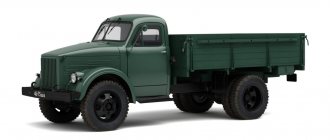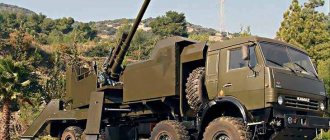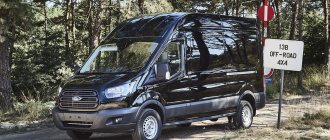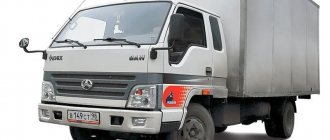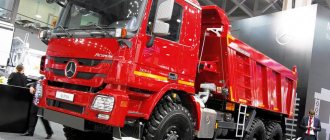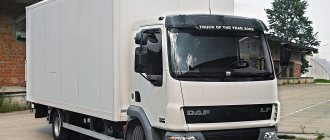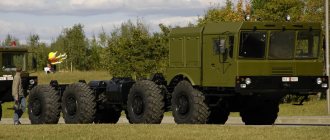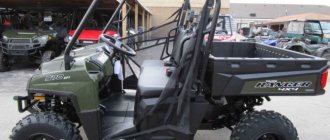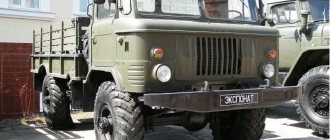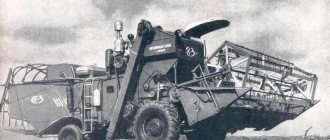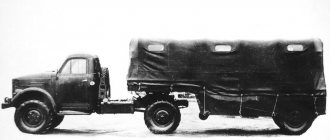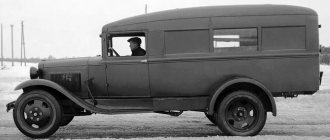Home » Cars » Tested in the USSR. All-wheel drive truck Praga V3S. Czechoslovakia
CarsUnrealized and little-known civil ground vehicle projects
boroda 03/13/2019 2083
14
in Favoritesin Favoritesfrom Favorites 8
Colleagues of the older generation, including myself, probably remember this car. Although not often, they could still be found on our roads in the 20th century. I didn’t know what kind of animal it was then. Then the cars disappeared completely. But, apparently, someone still has a working sample. And using his example, although it is late, there is an opportunity to become familiar with this technique in detail. Which is exactly what the journalists from the Kolesa.ru website did.
I love cars that attract attention. Here, for example, this Prague: a driver in only a T-shirt waved his hand from the cab of an oncoming Renault Magnum... I would wave to you too, brother, but I don’t have the opportunity to steer with one hand here. And cold. And there are still impudent people pressing behind us, for whom 50 km/h seems too slow. So let’s put on the face of a strong, independent man and move on.
All that's left is the name, only the name...
Today many people have forgotten about Czechoslovak Prague trucks. Some are able to discern in it some resemblance to the old Tatra, to others it seems like an unfinished ZiL with a broken nose. It’s a pity, because many interesting design ideas were embodied in these machines.
The history of the brand began in 1907, when an enterprise with the simple name “Prague Automobile Plant” was founded in Prague. In Bohemia at that time, the domestic automotive industry was even worse than it is now in Russia, so at first Isotta Fraschini, Charon and Renault were built at this plant.
It’s hard to say what prompted the leaders of this company to start developing their own trucks, but they did it. Perhaps a big order from the Austro-Hungarian army, which was itching to renew its fleet before the First World War, played a role. Be that as it may, the Prague Automobile Plant won the competition and received a military order, according to which almost a third of the military trucks of Austria-Hungary were to be received from this enterprise.
With great pleasure, the company switched to new militaristic lines and built a large number of modifications of military trucks, including all-terrain vehicles and trucks. They even built motorcycles and tractors, so success in the 20s and 30s was obvious and undeniable.
By the end of the 30s, the Prague Automobile Plant surpassed both Skoda and Tatra in quality and quantity of products. By 1939, the plant won several more competitions, opened a branch in Yugoslavia and expected unprecedented profits from World War II. But it didn’t work out.
The Germans were not very worried about Czechoslovak production. According to their good old tradition, they occupied everything that was possible, especially carefully nationalized everything that was not allowed, and forced them to build tank engines, all-terrain vehicles and parts for their own vehicles. Naturally, Allied bombs rained down on the heads of the factory workers. So successful that the plant in Prague was almost completely destroyed a couple of months before the end of the war.
Of course, restoring the plant was not an easy task, and the development of new machines in the first post-war years was impossible. They gradually returned to the production of pre-war models, but already in 1951 the military demanded that Prague make them a new truck. Three-axle, passable, simple and reliable. The kind that all military men love.
Vojenska 3tunová Special
It was impossible to joke with orders from such serious people back then. The car was built in just four months! It was so successful that after testing two prototypes, the trucks were put on the assembly line without altering the drawings. So in 1953, the first Vojenská 3tunová Speciální appeared - military three-ton special vehicles. As you already understood, hence the name of the model - V3S.
Let's say right away that three tons is such a good joke. In fact, with the carrying capacity it was much more interesting. Yes, nominally it is 3.3 tons. But it was stipulated that this was the carrying capacity on rough terrain. It was allowed to transport 5.3 tons on asphalt, and if not far, then 6.2 tons. Considering that the car still had at least some margin of safety, the indicated three tons seem ridiculous numbers.
“He must have a frame! Carrying such and such loads…” – someone will think. Well, how can I say... The V3S frame is really reliable, but at the same time it bends easily. And this is not a miscalculation of the designers, but their calculation: a frame of two spars connected by seven cross members has relatively weak resistance to torsion. And this, as you may have guessed, increases the suspension travel, which is very important for an all-terrain vehicle.
It’s actually strange that we started with the frame. Traditions are, of course, good, but the funniest element of Prague is the hood. If you fold it back (90 degrees, by the way!) and look at the car in profile, you might think that it has no engine at all. And there it is, and it’s an eight-liter fool. He just stands in the cabin, between the passenger and the driver. And from under the hood it is almost impossible to get to it; there is only access to the main attachments.
But it’s impossible to get to the cooling radiator from any side: it’s not here at all. Yes, there is an air-cooled diesel engine here. Looks like the familiar Tatra 815, doesn't it? This is understandable: Prague also has a Tatra engine. The volume of the six-cylinder in-line diesel Tatra T 912-2 is 8.1 liters, power is 110 hp. Some features of this engine can only be appreciated while driving, so these will be discussed below.
Since Prague was not built for asphalt, it has, of course, all-wheel drive. A transfer case with a reduction row and three driveshafts - everything is as it should be. The front axle is connectable, there is even inter-wheel locking on the rear axles. The gearbox is a four-speed, so we have as many as eight forward gears and two reverse gears at our disposal.
But what is not quite usual is the presence of wheel gearboxes. For the early fifties, this was still a rarity, but, apparently, the experience of working with the Germans affected this: they began installing them on their Kübelwagens and some other cars even before the start of World War II. In a word, the car’s off-road potential is enviable.
Comments
But what about the interior of this premium small SUV? But what about the interior of this premium small SUV? Continuing our QUBE/just-auto review of interior design and technology trends, we'll take a closer look. Are real estate sales in decline? It happens that manufacturers outperform each other in this regard and give inflated data, theoretically correct, what am I going to do? It happens that manufacturers outperform each other in this regard and give inflated data, theoretically correct, what am I going to do? example: Yacht 8m long / 2.5m wide / 3.5t weight / calm water without tug / calm weather / 30 lb engine, someone who sails on this engine knows that this makes no sense and is correct , But! such a motor is capable of accelerating this boat to 4 km/h, of course, not immediately. The same boat with a 55 lb engine reaches a speed of 5. What should you look for when purchasing? But what about the interior of this premium small SUV? Are real estate sales in decline? It happens that manufacturers outperform each other in this regard and give inflated data, theoretically correct, what am I going to do? It happens that manufacturers outperform each other in this regard and give inflated data, theoretically correct, what am I going to do?
Where did the motor go?
So, if you open the hood, you can't see the engine. But if you open the door to the cabin, it is impossible not to notice him. Why is he here? Who prevented it from being placed properly, outside? There is an opinion that this arrangement was chosen to ensure optimal weight distribution - the center of gravity of the massive diesel engine was in the base, behind the front axle. Now you can’t fit two passengers here - it’s too cramped with the engine.
But in general it is very strange that Prague’s ergonomics are head and shoulders above many of its contemporaries. Even rear-hinged doors, which you see less often on trucks than Ozzy Osbourne in a church, turned out to be very convenient here. You opened the door back, grabbed the handrail on the front pillar of the cab, climbed onto the step - and that’s it, you’re already inside. True, the footrest bends a little under my weight for some reason. Either the metal is already tired, or the structure is not strong enough, or someone is eating too much.
The driving position is, of course, upright, but quite spacious. Even the huge diameter steering wheel does not press against the seat, as happens on many Soviet and European trucks of that time.
All other controls also turned out to be exactly where we would like to see them. But the hint signs were a little confusing. My knowledge of the Czech language, ending with the words “jozhin s bazhin”, was not enough to understand what a “reel” is, which can be turned on or off, and what a “shame” is on the front panel. OK. We've seen everything, we can handle it without any help. Moreover, the switching scheme is still understandable, and it is classic. True, in order to engage reverse gear, the lever must not only be pulled towards you, but also lifted up. This is a kind of “foolproofing”.
Well, on the panel it is important for us to see the oil pressure light and the brake system pressure gauge scale. This is enough for us not to ruin the engine and not kill ourselves. Shall we try?
It's as cozy as a mother's tummy. But it is not exactly
0
Source:
All other controls also turned out to be exactly where we would like to see them. But the hint signs were a little confusing. My knowledge of the Czech language, ending with the words “jozhin s bazhin”, was not enough to understand what a “reel” is, which can be turned on or off, and what a “shame” is on the front panel. OK. We've seen everything, we can handle it without any help. Moreover, the switching scheme is still clear and it is classic. True, in order to engage reverse gear, the lever must not only be pulled towards you, but also lifted up. This is a kind of “foolproofing”.
Spin more, ask less
The trip began with a small quest “get out on the road.” The car was covered with snow, and a whole snowdrift was piled right in front of its face. The owner of the car, who had not yet received category C, simply opened the door for me and said “go ahead!” Hmm... He doesn't know if the front axle works. Let's try to go out like this, just on a low level.
Strange, but Prague drove over a snow block on two rear axles. Not right away, I had to rock her a little, but she came out. This is good: the test drive will definitely take place!
IT IS IMPOSSIBLE TO NOTE THAT THE EIGHT-LITER DIESEL, EVEN MUCH POWER, IN FIRST GEAR DRAWS THIS TRUCK JUST FANTASTICALLY. WHILE WE CROSSED THROUGH THE SNOW BARREL, LIKE SUVOROV THROUGH THE ALPS, HE DID NOT TRY TO STALL OUT FOR A SECOND.
Of course, I assumed that the military would not accept a completely dead car, but for its age the diesel engine is impressive. However, here it is worth paying attention to one detail: our car was produced in the early 80s and is slightly different from those produced in 1953. And the main difference is the engine. The first Tatra T 912 engines had a volume of 7.4 liters, were half of the V-shaped Tatra-111 engine and were very much unified with it. Our engine is a later one, but its only significant difference is its increased volume. Although the first engine produced 98 hp, so the difference is not too big.
But then the confusion begins. In the first Pragues the braking system was single-circuit, later it became double-circuit. This is exactly what we have. But at the same time, they began to install power steering on cars, but we don’t have it and never have. In addition, the latest V3S could already have pneumatic seats, but we don’t have them either. Most likely, such innovations were introduced gradually. Or maybe they had some kind of “packages”, and we got some kind of “drum edition”. There is no one to ask about this now.
Getting out onto the road was difficult: we had to weave among parked cars. Eh, it would be easier with power steering... And the maneuverability is not very good. But the visibility is excellent: leaning forward a little, you can see the front fenders. So the absence of a long muzzle a la Kraz-256 makes life easier. The engine wouldn’t scream at hand...
Finally we reached the public road. Yes, catching the glances and smiles of oncoming drivers is, of course, pleasant. But at the same time I looked in the rearview mirror. It’s unlikely that the convoy of cars behind me was so happy about the presence of an old all-terrain vehicle on the road. And all because, alas, he is not adapted to such roads.
The maximum speed according to the passport is 60 km/h. But it’s better not to accelerate it faster than 50: then the eardrums are finally pressed into the skull and damage the remains of the brain.
Prague listens very well to the steering wheel and is almost indifferent to manipulations with the brake pedal. It's like there's a brick underneath. It’s good that the speed of the car is such that you can do without brakes, working exclusively with the gas pedal, and using the brake only to come to a complete stop.
But the car has a very unpleasant feature - the gear ratios of the third and fourth gears are not quite well chosen. To successfully switch to fourth, the engine has to be cranked very hard, and in the end, after switching, there are still not enough of them - one more gear is asked between third and fourth... A very similar situation was in the “groove”. But here the “air” diesel surprised me again. Unlike its fellow lovers of diesel fuel, this engine really respects high speeds. Don't feed it oil, let it unwind well. This is probably a family trait of Tatra diesels - to have a slightly “gasoline” character. And you have to get used to it.
Turn on your reel: test drive Praga V3S
All that's left is the name, only the name...
Today many people have forgotten about Czechoslovak Prague trucks.
Some are able to discern in it some resemblance to the old Tatra, to others it seems like an unfinished ZiL with a broken nose. It’s a pity, because many interesting design ideas were embodied in these machines. The history of the brand began in 1907, when an enterprise with the simple name “Prague Automobile Plant” was founded in Prague. In Bohemia at that time, the domestic automotive industry was even worse than it is now in Russia, so at first Isotta Fraschini, Charon and Renault were built at this plant.
It’s hard to say what prompted the leaders of this company to start developing their own trucks, but they did it. Perhaps a big order from the Austro-Hungarian army, which was itching to renew its fleet before the First World War, played a role. Be that as it may, the Prague Automobile Plant won the competition and received a military order, according to which almost a third of the military trucks of Austria-Hungary were to be received from this enterprise.
Articles / Czech Republic That's it: the Czech auto industry of the times of socialism From the author: even before you start reading this material, I would like to make a reservation that I tried to focus specifically on the socialist period, since the whole history of the Czech auto industry is too... 25354 4 13 18.03. 2016
With great pleasure, the company switched to new militaristic lines and built a large number of modifications of military trucks, including all-terrain vehicles and trucks. They even built motorcycles and tractors, so success in the 20s and 30s was obvious and undeniable.
By the end of the 30s, the Prague Automobile Plant surpassed both Skoda and Tatra in quality and quantity of products. By 1939, the plant won several more competitions, opened a branch in Yugoslavia and expected unprecedented profits from World War II. But it didn’t work out.
The Germans were not very worried about Czechoslovak production. According to their good old tradition, they occupied everything that was possible, especially carefully nationalized everything that was not allowed, and forced them to build tank engines, all-terrain vehicles and parts for their own vehicles. Naturally, Allied bombs rained down on the heads of the factory workers. So successful that the plant in Prague was almost completely destroyed a couple of months before the end of the war.
Of course, restoring the plant was not an easy task, and the development of new machines in the first post-war years was impossible. They gradually returned to the production of pre-war models, but already in 1951 the military demanded that Prague make them a new truck. Three-axle, passable, simple and reliable. The kind that all military men love.
Vojenska 3tunová Special
It was impossible to joke with orders from such serious people back then. The car was built in just four months! It was so successful that after testing two prototypes, the trucks were put on the assembly line without altering the drawings. So in 1953, the first Vojenská 3tunová Speciální appeared - military three-ton special vehicles. As you already understood, hence the name of the model - V3S.
Let's say right away that three tons is such a good joke. In fact, with the carrying capacity it was much more interesting. Yes, nominally it is 3.3 tons. But it was stipulated that this was the carrying capacity on rough terrain. It was allowed to transport 5.3 tons on asphalt, and if not far, then 6.2 tons. Considering that the car still had at least some margin of safety, the indicated three tons seem ridiculous numbers.
“He must have a frame! Carrying such and such loads…” – someone will think. Well, how can I say... The V3S frame is really reliable, but at the same time it bends easily. And this is not a miscalculation of the designers, but their calculation: a frame of two spars connected by seven cross members has relatively weak resistance to torsion. And this, as you may have guessed, increases the suspension travel, which is very important for an all-terrain vehicle.
It’s actually strange that we started with the frame. Traditions are, of course, good, but the funniest element of Prague is the hood. If you fold it back (90 degrees, by the way!) and look at the car in profile, you might think that it has no engine at all. And there it is, and it’s an eight-liter fool. He just stands in the cabin, between the passenger and the driver. And from under the hood it is almost impossible to get to it; there is only access to the main attachments.
But it’s impossible to get to the cooling radiator from any side: it’s not here at all. Yes, there is an air-cooled diesel engine here. Looks like the familiar Tatra 815, doesn't it? This is understandable: Prague also has a Tatra engine. The volume of the six-cylinder in-line diesel Tatra T 912-2 is 8.1 liters, power is 110 hp. Some features of this engine can only be appreciated while driving, so these will be discussed below.
Since Prague was not built for asphalt, it has, of course, all-wheel drive. A transfer case with a reduction row and three driveshafts - everything is as it should be. The front axle is connectable, there is even inter-wheel locking on the rear axles. The gearbox is a four-speed, so we have as many as eight forward gears and two reverse gears at our disposal.
But what is not quite usual is the presence of wheel gearboxes. For the early fifties, this was still a rarity, but, apparently, the experience of working with the Germans affected this: they began installing them on their Kübelwagens and some other cars even before the start of World War II. In a word, the car’s off-road potential is enviable.
1 / 2
2 / 2
Where did the motor go?
So, if you open the hood, you can't see the engine. But if you open the door to the cabin, it is impossible not to notice him. Why is he here? Who prevented it from being placed properly, outside? There is an opinion that this arrangement was chosen to ensure optimal weight distribution - the center of gravity of the massive diesel engine was in the base, behind the front axle. Now you can’t fit two passengers here - it’s too cramped with the engine.
But in general it is very strange that Prague’s ergonomics are head and shoulders above many of its contemporaries. Even rear-hinged doors, which you see less often on trucks than Ozzy Osbourne in a church, turned out to be very convenient here. You opened the door back, grabbed the handrail on the front pillar of the cab, climbed onto the step - and that’s it, you’re already inside. True, the footrest bends a little under my weight for some reason. Either the metal is already tired, or the structure is not strong enough, or someone is eating too much.
The driving position is, of course, upright, but quite spacious. Even the huge diameter steering wheel does not press against the seat, as happens on many Soviet and European trucks of that time.
All other controls also turned out to be exactly where we would like to see them. But the hint signs were a little confusing. My knowledge of the Czech language, ending with the words “jozhin s bazhin”, was not enough to understand what a “reel” is, which can be turned on or off, and what a “shame” is on the front panel. OK. We've seen everything, we can handle it without any help. Moreover, the switching scheme is still understandable, and it is classic. True, in order to engage reverse gear, the lever must not only be pulled towards you, but also lifted up. This is a kind of “foolproofing”.
Well, on the panel it is important for us to see the oil pressure light and the brake system pressure gauge scale. This is enough for us not to ruin the engine and not kill ourselves. Shall we try?
1 / 5
2 / 5
3 / 5
4 / 5
5 / 5
Spin more, ask less
The trip began with a small quest “get out on the road.” The car was covered with snow, and a whole snowdrift was piled right in front of its face. The owner of the car, who had not yet received category C, simply opened the door for me and said “go ahead!” Hmm... He doesn't know if the front axle works. Let's try to go out like this, just on a low level.
Strange, but Prague drove over a snow block on two rear axles. Not right away, I had to rock her a little, but she came out. This is good: the test drive will definitely take place!
It should be noted that the eight-liter diesel engine, albeit of low power, pulls this truck in first gear simply fantastically. While we were rolling over the snowy blockage, like Suvorov through the Alps, he didn’t try to stall for a second.
Of course, I assumed that the military would not accept a completely dead car, but for its age the diesel engine is impressive. However, here it is worth paying attention to one detail: our car was produced in the early 80s and is slightly different from those produced in 1953. And the main difference is the engine. The first Tatra T 912 engines had a volume of 7.4 liters, were half of the V-shaped Tatra-111 engine and were very much unified with it. Our engine is a later one, but its only significant difference is its increased volume. Although the first engine produced 98 hp, so the difference is not too big.
But then the confusion begins. In the first Pragues the braking system was single-circuit, later it became double-circuit. This is exactly what we have. But at the same time, they began to install power steering on cars, but we don’t have it and never have. In addition, the latest V3S could already have pneumatic seats, but we don’t have them either. Most likely, such innovations were introduced gradually. Or maybe they had some kind of “packages”, and we got some kind of “drum edition”. There is no one to ask about this now.
Getting out onto the road was difficult: we had to weave among parked cars. Eh, it would be easier with power steering... And the maneuverability is not very good. But the visibility is excellent: leaning forward a little, you can see the front fenders. So the absence of a long muzzle a la Kraz-256 makes life easier. The engine wouldn’t scream at hand...
Finally we reached the public road. Yes, catching the glances and smiles of oncoming drivers is, of course, pleasant. But at the same time I looked in the rearview mirror. It’s unlikely that the convoy of cars behind me was so happy about the presence of an old all-terrain vehicle on the road. And all because, alas, he is not adapted to such roads.
View this post on Instagram
Publication from Kolesa.ru (@kolesaru)
The maximum speed according to the passport is 60 km/h. But it’s better not to accelerate it faster than 50: then the eardrums are finally pressed into the skull and damage the remains of the brain.
Prague listens very well to the steering wheel and is almost indifferent to manipulations with the brake pedal. It's like there's a brick underneath. It’s good that the speed of the car is such that you can do without brakes, working exclusively with the gas pedal, and using the brake only to come to a complete stop.
But the car has a very unpleasant feature - the gear ratios of the third and fourth gears are not quite well chosen. To successfully switch to fourth, the engine has to be cranked very hard, and in the end, after switching, there are still not enough of them - one more gear is asked between third and fourth... A very similar situation was in the “groove”. But here the “air” diesel surprised me again. Unlike its fellow lovers of diesel fuel, this engine really respects high speeds. Don't feed it oil, let it unwind well. This is probably a family trait of Tatra diesels - to have a slightly “gasoline” character. And you have to get used to it.
Understatement
Now let's say a few words about the history of our car. Nobody knows how and when it appeared in the USSR. But we can definitely say that this is a mobile fluorographic installation. Firstly, it was in this form that Prague most often came here from fraternal Czechoslovakia, and secondly, the kung speaks about this. True, the previous owner was a noble sybarite: all the medical stuffing was thrown out, and there were obscene-looking sofas inside. Over time, his health apparently began to fail him, and the sofas were littered with all sorts of rubbish as unnecessary. I wouldn’t like to see who had fun here and how, but the sunroof is a luxury. As well as the “oars” of the window lifters - you rarely see this in a kung.
This car was bought, as is often the case with cargo rarities, “off the fence.” Nobody drove it for a long time, the wheels were completely squared up, the wiring was rotten, the generator died. There was no battery at all. And yet Prague drove to its destination on its own, and this is - just imagine - one and a half thousand kilometers! And she was driving without a generator. An old-school diesel engine doesn’t need it at all: it needs to be started once, and then it threshes on its own, requiring only air and diesel fuel. The battery died solely because of the headlights - according to traffic regulations, you cannot drive without them.
By the way, the traffic cops along the way were very interested in this car. They stopped us, took a selfie and let us go. But one still fined for the lack of compulsory motor insurance, although with a purchase and sale agreement you can drive for 10 days without insurance. Apparently, the inspector realized that he would not have another chance to fine the Prague driver, and decided to have a blast. What to do: at least somehow he made it into history. Congratulations!
Understatement
Now let's say a few words about the history of our car. Nobody knows how and when it appeared in the USSR. But we can definitely say that this is a mobile fluorographic installation. Firstly, it was in this form that Prague most often came here from fraternal Czechoslovakia, and secondly, the kung speaks about this. True, the previous owner was a noble sybarite: all the medical stuffing was thrown out, and there were obscene-looking sofas inside. Over time, his health apparently began to fail him, and the sofas were littered with all sorts of rubbish as unnecessary. I wouldn’t like to see who had fun here and how, but the sunroof is a luxury. As well as the “oars” of the window lifters - you rarely see this in a kung.
This car was bought, as is often the case with cargo rarities, “off the fence.” Nobody drove it for a long time, the wheels were completely squared up, the wiring was rotten, the generator died. There was no battery at all. And yet Prague drove to its destination on its own, and this is - just imagine - one and a half thousand kilometers! And she was driving without a generator. An old-school diesel engine doesn’t need it at all: it needs to be started once, and then it threshes on its own, requiring only air and diesel fuel. The battery died solely because of the headlights - according to traffic regulations, you cannot drive without them.
By the way, the traffic cops along the way were very interested in this car. They stopped us, took a selfie and let us go. But one still fined for the lack of compulsory motor insurance, although with a purchase and sale agreement you can drive for 10 days without insurance. Apparently, the inspector realized that he would not have another chance to fine the Prague driver, and decided to have a blast. What to do: at least somehow he made it into history. Congratulations!
Source – https://www.kolesa.ru/test-drive/vklyuchaj-svoyo-motovilo-test-drajv-praga-v3s
